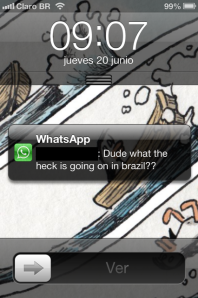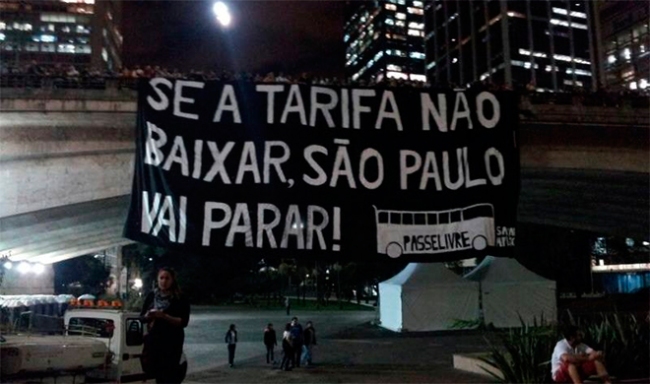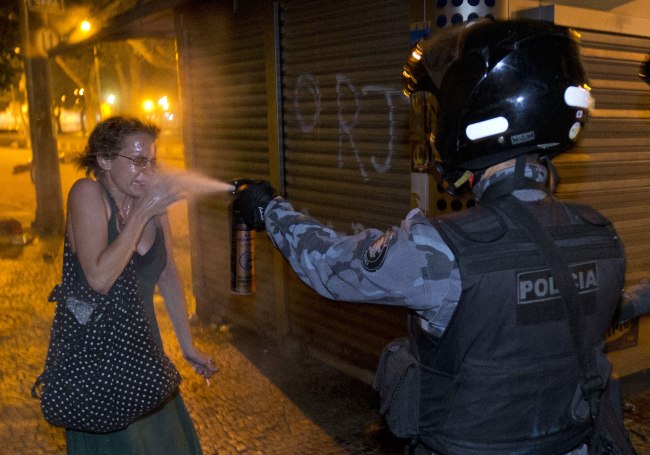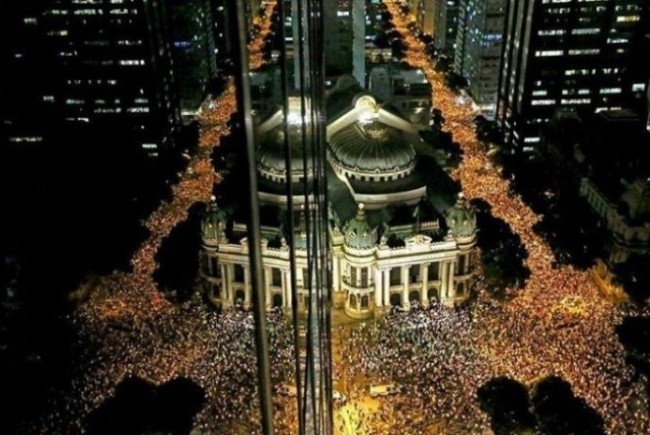People all over the world have been asking us, Brazilians, exactly that. We don’t really know, but we are trying to figure it out. For foreigners, information is only available from the main foreign media outlets such as “The Economist”, “El País”, and “The New York Times”. Though these sources do their job, they don’t tell the other sides of the story, as neither do the main Brazilian newspapers nor TV channels. Our purpose here is to offer different perspectives by collecting the most interesting analyses and news articles produced on daily basis by Brazil’s alternative and popular media. Let’s make ideas circulate!
About a couple of weeks ago, the Free Pass Movement mobilized thousands of people against an increase in the bus fare in São Paulo.
(#freepass The movement is called “free pass” because they consider transportation to be a basic need and think bus fares should be totally free. Some city planners also think that a “free pass” could help solve mobility issues in cities, such as traffic congestion. Some economists think that a free system would be more efficient and also the economy as a whole could gain by further decreasing inequality – poor people spend over a fifth of their income on transportation.)
Demonstrations were peaceful, most of them led by college students, social movement groups, and leftist parties. Brazil’s poor public transportation system was the main reason behind the initial protests. Therefore, protestors strategically sought to reach Avenida Paulista, São Paulo’s and Brazil’s most important thoroughfare, an act that would stop the city and bring attention to the demonstrations. From the government’s perspective, the protests would also create more “chaos” to the city’s urbanites.
Therefore, the police had to stop them –and media outlets agreed: protesters were either “spoiled young kids who don’t even take the bus” or were “irresponsible rioters who had to be repressed”. (#militarypolice Brazil has a “military police”, an organ inherited from the era of the dictatorship and already condemned by the UN. Whenever governments want to “maintain order” at any cost, they call the military police. It works perfectly when they want to contain poor black young people in favelas. But things can get “complicated” when they start firing rubber bullets at affluent white youngsters on the country’s main avenue…)
When protesters tried to reach Avenida Paulista once again on Thursday June 13th, police got “completely out of control.” The military police sprayed tear gas and fired rubber bullets indiscriminately into the crowds, injuring bystanders and clearly recognizable journalists from mainstream media. Suddenly, media outlets started to change their minds: the police was brutal, after all.
The newspapers began to conduct polls: “are you in favor or against protests?” To the mainstream media’s surprise, most people supported the protestors. Newspapers and TV networks changed their tone completely. And then something unexpected happened. On Monday June 17th, a demonstration in Rio de Janeiro, where social movement groups were already protesting against the bus fare increase and huge public investments in the World Cup, and another one in São Paulo had more people than ever. People were also protesting for the right to demonstrate without being brutally assaulted by the police.
However, those bigger demonstrations started to look a bit different from the previous ones. First, the type of demands changed from a few concrete demands such as reduced bus fares, to a variety of vague demands such as the end of corruption. Second, protest neophytes began to discriminate against members of leftist political parties, who had been participating in the protests since the beginning. Those were localized problems… or so we thought.
From Tuesday June 18th, protests started to happen everywhere. From small towns in the north to large capitals in the south, the government saw dozens of thousands of citizens marching. Things quickly got out of hand for the government and the politically engaged protesters who started the wave of demonstrations in the first place.
First, the new demands started to look dangerous. For instance, a considerable number of people proposed the impeachment of President Dilma Rousseff (from Lula’s Workers Party [PT]), in a clearly demagogical pledge. Second, the attacks on representatives of social movements and leftist parties increased and got nastier, with neo-protesters, who say they are against “any kind of party”, burning party flags and harassing their members. Third, a considerable amount of protesters started to vandalize public places – such as the city hall in São Paulo and the Ministry of International Affairs (Itamaraty) in Brasilia.
Municipal governments all over the country started to decrease bus fare on Tuesday, but it didn’t stop people from going to the streets (in Rio de Janeiro, they were more than three hundred thousand people on June 20th). But now demonstrations have departed from concrete issues like public transportation and World Cup administration and became some sort of “social catharsis” for all of Brazil’s problems.
The mainstream media and conservative sectors of the society – who started to see this as a “great democratic party” with “punctual problems of vandalism”– dispute the movement with the leftist and liberal sectors who gave birth to it.
###




